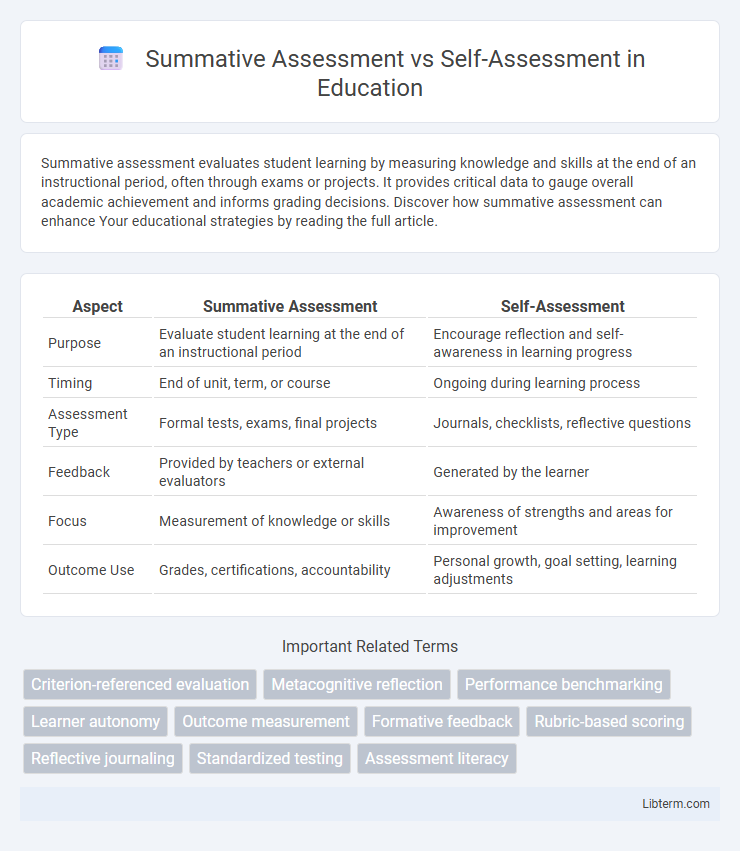Summative assessment evaluates student learning by measuring knowledge and skills at the end of an instructional period, often through exams or projects. It provides critical data to gauge overall academic achievement and informs grading decisions. Discover how summative assessment can enhance Your educational strategies by reading the full article.
Table of Comparison
| Aspect | Summative Assessment | Self-Assessment |
|---|---|---|
| Purpose | Evaluate student learning at the end of an instructional period | Encourage reflection and self-awareness in learning progress |
| Timing | End of unit, term, or course | Ongoing during learning process |
| Assessment Type | Formal tests, exams, final projects | Journals, checklists, reflective questions |
| Feedback | Provided by teachers or external evaluators | Generated by the learner |
| Focus | Measurement of knowledge or skills | Awareness of strengths and areas for improvement |
| Outcome Use | Grades, certifications, accountability | Personal growth, goal setting, learning adjustments |
Understanding Summative Assessment
Summative assessment evaluates student learning at the end of an instructional period by measuring overall achievement against defined standards or benchmarks. Common formats include final exams, standardized tests, and end-of-term projects, providing quantifiable data on academic performance for grading and curriculum evaluation. This type of assessment emphasizes accountability and informs decisions on student progression, curriculum effectiveness, and instructional quality.
Defining Self-Assessment
Self-assessment is the process where learners evaluate their own understanding, skills, and performance against established criteria or learning goals. This method promotes metacognition by encouraging students to reflect on their strengths and areas for improvement, enhancing their ability to regulate their own learning. Unlike summative assessment, which provides a final evaluation of learning outcomes, self-assessment is formative and ongoing, fostering continuous personal growth in educational settings.
Key Differences Between Summative and Self-Assessment
Summative assessment evaluates student learning at the end of an instructional period by measuring achievement against standardized criteria, often in the form of exams or final projects. Self-assessment involves students reflecting on their own learning process, identifying strengths and weaknesses, and setting personal goals to enhance understanding. Key differences include the focus on external evaluation for summative assessment versus internal reflection in self-assessment, as well as their distinct roles in measuring outcomes versus promoting metacognitive skills.
Purposes and Objectives of Assessments
Summative assessment aims to evaluate student learning by measuring achievement against predefined standards at the end of an instructional period, providing data for grading and accountability. Self-assessment focuses on promoting learner metacognition and self-regulation by encouraging students to reflect on their own performance and identify areas for improvement. While summative assessments provide objective evidence of mastery, self-assessments serve formative purposes, enhancing motivation and fostering deeper understanding.
Advantages of Summative Assessment
Summative assessment provides a clear, objective measure of student learning outcomes at the end of an instructional period, facilitating standardized evaluation across diverse learners. It enables educators to identify gaps in knowledge and curriculum effectiveness through quantifiable data, supporting accountability in educational institutions. The formal structure and comparability of summative assessments help guide future instructional planning and policy decisions.
Benefits of Self-Assessment
Self-assessment enhances learner autonomy by encouraging reflection on personal strengths and weaknesses, leading to improved metacognitive skills. It fosters intrinsic motivation and responsibility for learning outcomes, promoting deeper understanding and engagement with the material. Through regular self-evaluation, students develop critical thinking skills and become more effective at setting goals and monitoring their own progress.
Limitations of Summative and Self-Assessment
Summative assessment often faces limitations such as providing only a snapshot of learner performance at a single point, potentially overlooking ongoing progress and diverse learning styles. Self-assessment can be hindered by learners' lack of objectivity, metacognitive skills, or motivation, which may lead to inaccurate or overly lenient evaluations. Both methods may fail to fully capture the complexity of learning outcomes, underscoring the need for complementary assessment strategies.
Impact on Student Learning Outcomes
Summative assessment provides a comprehensive evaluation of student learning at the end of an instructional period, offering critical data for educators to measure overall achievement and curriculum effectiveness. Self-assessment encourages students to develop metacognitive skills, fostering deeper engagement and ownership of their learning process, which improves retention and motivation. Combining both methods enhances student learning outcomes by balancing objective performance measurement with reflective learning practices.
Integrating Both Assessments in Education
Integrating summative assessment and self-assessment in education enhances learner engagement and improves performance by combining objective evaluation with reflective practice. Summative assessments provide measurable outcomes of student learning at specific points, while self-assessments encourage critical thinking and personal goal setting. Blending these methods supports a comprehensive understanding of student progress and fosters autonomous, lifelong learning skills.
Best Practices for Effective Assessment Strategies
Summative assessment measures student learning at the end of an instructional period, providing data for grading and curriculum adjustment, while self-assessment encourages learner reflection and promotes metacognitive skills. Best practices for effective assessment strategies include aligning assessment criteria with learning objectives, ensuring clear rubrics for consistency, and incorporating opportunities for student self-evaluation to foster autonomy and deeper understanding. Combining summative assessment with self-assessment allows educators to capture comprehensive performance insights and support continuous improvement.
Summative Assessment Infographic

 libterm.com
libterm.com